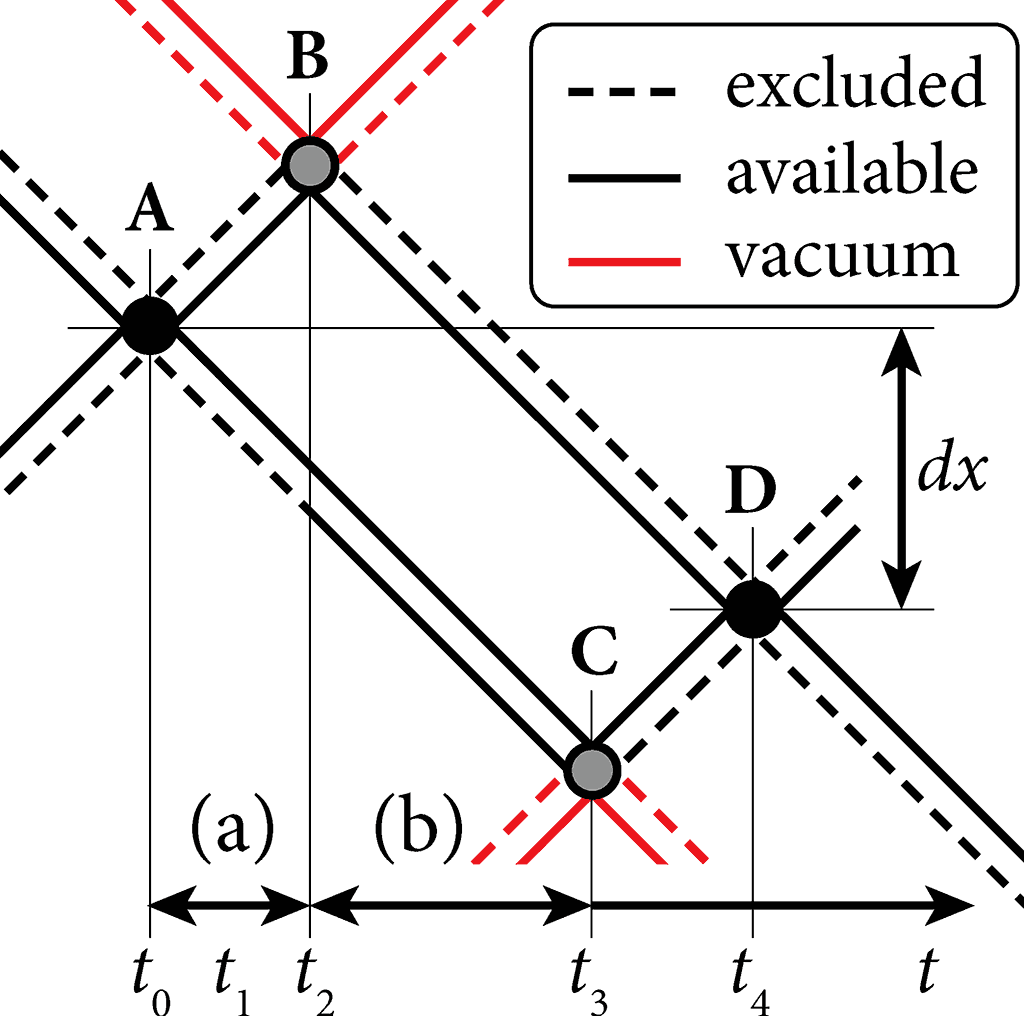Here we'll look at what charge is, what an electric current is, what magnetic flux is, how they relate in our picture, and how this picture reconciles with classical electromagnetism. Then we'll explore some aspects of the picture.
Charge
This is whether the particle (fermion or composite) conducts vacuum energy during its reconstitution process.

Fig.1: Conserved re-constitution of an electron-type fermion.
To understand what this means, we should look at the reconstitution process (fig.1), and follow what happens to bosons in this structure. For every fermion that de-constitutes, two bosons emerge. One of them could have more mass-energy than the other (we'll assume that is the case throughout this example), and is therefore more likely to be the 'conserved' aspect of the fermion's constitution, so it (the very same boson) revisits what we see as the 'persistent fermion' state.
A lower mass-energy allows the boson to propagate further without collapse, which allows them to reconstitute with other particles instead of the original fermion. In an environment where many bosons of low mass-energy are passing through, it's easy for these to swap in and out, while the more massive boson remains near the centre of the fermion's expected position.
A charged particle is therefore one that admits the environmental bosons into its own structure, so at fermion B (fig.1), a boson of sub-path B–D would be red, indicating the admission of a vacuum boson, while the boson leaving the diagram after B would be black, indicating that the boson is the same as the one that left A.
Attribution of wave sources.[15]
To see how this is the basis of electromagnetism, we need to look at the detail.
Electromagnetism
We can see that for each cycle of fermion reconstitution, there are two component bosons: the persistent part that is observed as the moving charged component, and the magnetic flux component.
Without an environmental vacuum flux, there can be no local eletromagnetism, except that within conserved confined particles.
Electric current
The electric current is the movement of the boson having high mass-energy. It is identified with the movement of charged matter in electrodynamics equations.
Magnetic flux
The electric current is the movement of the boson having low mess-energy: the counterpart boson to the high-mass-energy boson; together they make up the fermion.
After leaving the fermion, these bosons may take a path, becoming a part of other fermions (whether temporary and instantaneous, like vacuum interactions, or conserved, like the fermion formed with the massive boson). Given sufficient coherence and quantity of bosons, this may form a significant flux, and may form a dipole circuit with another charged fermion.
Photons*
Photons are paired boson impulses, absorbed by structures like their emitters, having a frequency that may be derived from a sparse sampling of impulses
Photon emission.
Aspects
Coherence and conservation of type
For a fermion to be regarded as conserved or persistent, it only needs to re-form with bosons having the same properties as the original constitution, but the bosons do not need to have the same identity, i.e. bosons can be swapped in from vacuum and vice versa.
There are actually two opportunities for substitution, and if either occurs, then the particle identity is not wholly conserved. As observers we tend only to follow the boson having significantly higher mass-energy, and we can regard the fermion as persistent if only the flux term changes for another having the same properties. If we imagine trying to follow the flux term, then the high-mass-energy component will seem to have been substituted. These might seem different processes, but they are merely two viewpoints into the same underlying process.
If bosons having different properties became substituted, then the particle would be observed to change.
Confinement
Electromagnetism (or its components) can be confined, when other fermions of the system are constituted using the bosons that would have been associated with the flux. Here's a simplified diagram of quarks and their bosons (gluons), where bosons are confined, and quarks are able to expose charge for only a fraction of the interactions available to the composite.

Fig.4: Conserved re-constitution of quark-type fermions (simplified).
Dynamic or static?
Even a 'classically stationary' fermion is made up of bosons that are always moving at light speed: the fermion re-constitutes in approximately the same place every time. This still admits electromagnetism, because there is opportunity for the environmental bosons to temporarily become part of this fermion.
Circuits
A circuit is formed when a boson takes a closed path. So according to the above picture, we may have circuits of electric current, and circuits of magnetic flux. The electric circuit is likely to be a smaller loop, through matter, with the magnetic circuit taking a wider path through the surrounding space. Having said that, there is no need for field lines to form strict circuits; the vacuum can act as source and sink, without there necessarily being a coherent circuit.
Plasma
Where fermions have temporary identity (i.e. their components do not re-unite), we call this a plasma. The charge characteristics of this plasma will be different from that of the 'conserved fermion' case, because the plasma will more readily conduct a wider spectrum of (mass-energy of) bosons, and the ratio of heavy:light substitutions will be skewed more towards the heavy, taking some away from the light.
Other flux?
In the above picture, it's possible to have currents of vacuum bosons that are not associated with coherent charged particles.